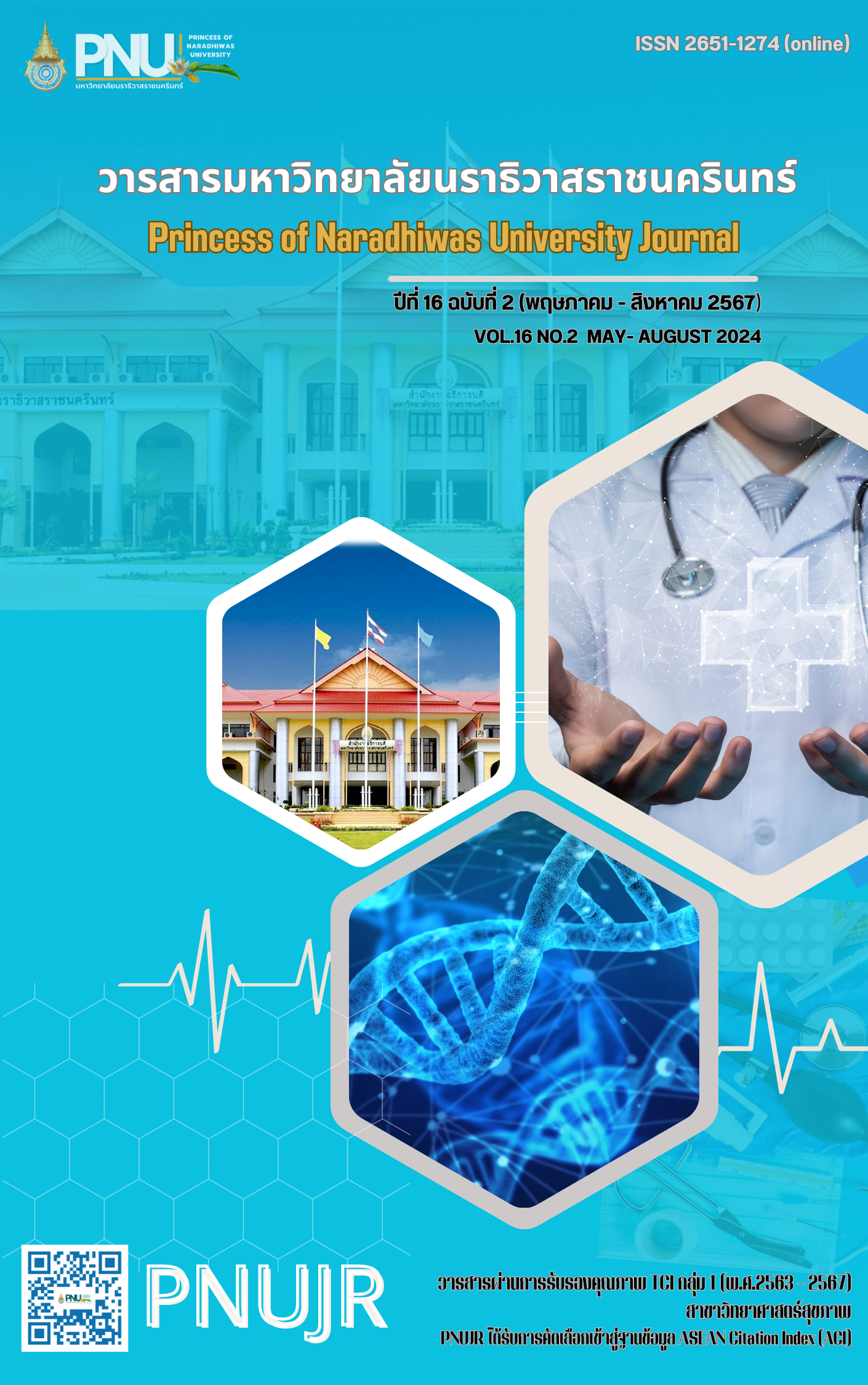Burnout among Registered Nurses Working at A Tertiary Care Hospital of Southern Region
Fa-is Walohtae
Keywords:
Burnout, Registered nurses, A tertiary care hospital of southern regionAbstract
The purposes of this descriptive study were to: 1) determine the level of burnout experienced by registered nurses working at a tertiary care hospital in the southern region; and 2) investigate methods for reducing burnout among these nurses. The samples group was split into two groups: thirty samples who completed questionnaires and ten samples who chose to participate in a brief focus group discussion by choosing from the same group of samples. Two types of questionnaires were used: 1) a measurement of burnout among registered nurses which had an Alpha Cronbach’s coefficient of 0.85 and a content validity index of 1; and 2) a semi-structured interview questionnaire for focus group discussions with registered nurses which had an Alpha Cronbach's coefficient of 0.97 and a content validity index of 1. Data analysis used descriptive statistics such as percentage, mean, standard deviation, and content analysis.
Results found that an average overall burnout score for registered nurses working in a tertiary hospital in the southern region was found to be moderate (M = 2.50, SD. =0.65). When each component was examined, it was found that the working part had the highest average burnout score (M = 3.19, S.D. = 0.94), followed by the organizational part and the personal part (physical fatigue) (M = 2.68, S.D. = 0.90, M = 2.66, S.D. = 0.74) respectively, and the aspect of burnout that registered nurses experienced at the lowest level was personal part (emotional exhaustion and Cognitive weariness) (M = 1.99, S.D. = 0.69, M = 1.99, S.D. = 0.78) respectively, The following were strategies to help registered nurses who were working professionally experience less burnout: 1) sleep and rest; 2) self-care; 3) balanced nutrition; 4) working plan; 5) balanced working schedule; 6) effective communication with coworkers; 7) stress management; and 8) mental health promotion.
References
Axisa, C., Nash, L., Kelly, P., & Willcock, S. (2019). Burnout and distress in Australian physician trainees: Evaluation of a wellbeing workshop. Australas Psychiatry, 27(3), 255 - 261. http://doi.org/10.1177/1039856219833793
Chamakiotis, P., Panteli, N., & Davison, R.M. (2021). Reimagining e-leadership for reconfigured virtual teams due to Covid-19. International Journal of Information Management, Elsevier, 60(C). http://doi.org/10.1016/j.ijinfomgt.2021.102381
Chen, Y.-C, Guo, Y.- L.L, Chin, W.-S, Cheng, N.-Y, Ho, J.-J, & Shiao, J.S.-C. (2019). Patient–Nurse
Ratio is Related to Nurses’ Intention to Leave Their Job through Mediating Factors of Burnout and Job Dissatisfaction. International Journal Environmental Research and Public Health, 16(23), 4801. http://doi.org/10.3390/ijerph16234801
Jintarat, B., & Sithisarankul, P. (2022). Emotional labor and burnout in nursing profession. Journal of
Preventive Medicine Association of Thailand, 11(2), 435 - 446. https://he01.tci-thaijo.org/ index.php/JPMAT/article/view/248421
Klein, A., Taieb, O., Xavier, S., Baubet, T., & Reyre, A. (2020). The benefits of mindfulness-based interventions on burnout among health professionals: A systematic review. Explore (NY), 16(1), 35 - 43. http://doi.org/10.1016/j.explore.2019.09.002
Krejcie, R.V., & Morgan, D.W. (1970). Determining Sample Size for Research Activities. Educational And Psychological Measurement, 30(3), 607 - 610. https://psycnet.apa.org/ record/1971-03263-001
McCormack, N., & Cotter, C. (2013, October). Managing Burnout in the Workplace: A Guide for Information Professionals. https://www.researchgate.net/publication/282177798_ManagingBurnout_in_the_Workplace_A_ Guide_for_Information_Professionals
Ministry of Labor Safety Act Occupational health and working environment. (2021, August 6). The act clarifies responsibilities and duties of employer and employee as well as those of governments. https://enviliance.com/regions/southeast-asia/th/th-osh
Ministry of Public Health. (2021, December 22). Criteria for risk reimbursement of staff working in surveillance, investigation, prevention, control and treatment of patients infected with Coronavirus 2019. https://hp.anamai.moph.go.th/th/manual-ofofficial/download?id=86033& mid=35018&mkey=m_document&lang=th&did=27817
Nantsupawat, A., Nantsupawat, R., Kunaviktikul, W., Turale, S., & Poghosyan, L. (2016). Nurse Burnout, Nurse-Reported Quality of Care, and Patient Outcomes in Thai Hospitals. Journal of Nursing Scholarship, 48(1), 83 - 90. http://doi.org/10.1111/jnu.12187
No-in, K., Cheevakasemsook, A., & Angsuchoti, S. (2021). The development of a reducing burnout model for professional nursesin a community hospital A reducing burnout model for professional nurses in a community hospital. Journal of Mental Health of Thailand, 29(1), 69 – 79. http://he01-tci-thaijo.org/index.php/jmht/ article/view/242178/168170
Omotade, S.J., Okafor, N., Omolayo, F., & Tajat, M.O. (2021). Prevalence of burnout syndrome among clinical nurses working at state hospital, Ijaye, Abekotuka, Ogun state, Nigeria. African Journal of Health Nursing and Midwifery, 4(5), 85 – 101. https://doi.org/ 10.52589/AJHNM-JXC09CBZ
Rezaei, S., Matin, B.K., Hajizadeh, M., Soroush, A., & Nouri, B. (2018). Prevalence of burnout among nurses in Iran: a systematic review and meta-analysis. International Nursing Review, 65(3), 361 - 369. http://doi.org/10.1111/inr.12426
Ramírez-Elvira, S., Romero-Béjar, J.L., Suleiman-Martos, N., Gómez-Urquiza, J.L., Carolina, M., Guillermo, L.F., & Albendín-García, L. (2021). Prevalence, Risk Factors and Burnout Levels in Intensive Care Unit Nurses: A Systematic Review and Meta-Analysis. International Journal of Environmental Research and Public Health, 18(21), 11432. https://doi.org/10.3390/ijerph182111432
Shirom, A., & Melamed, S. (2006). A comparison of the construct validity of two burnout measures in two groups of professionals. International Journal of Stress Management, 13(2), 176 - 200. https://doi.org/10.1037/1072-5245.13.2.176.
Thamrongvisava, S., Pitanupong, J., & Srisintorn, W. (2019). Burnout andassociated factors among nurses at Songklanagarind Hospital. Royal Thai Army Medical Journal, 72(3),177-185. https://he02.tci-thaijo.org/index.php/rtamedj/article/view/218984
Tianjaruwattana, W., & Nawsuwan, K. (2021). Development of the public health workforce of the office of the permanent secretary, Ministry of Public Health to support health region. Journal of Health Science, 30(3), 531 - 546. https://thaidj.org/index.php/JHS/ article/view/10223
Wisetborisut, A., Angkurawaranon, C., Jiraporncharoen, W., Uaphanthasath, R., & Wiwatanadate, P. (2014). Shift work and burnout among health care workers. Occupational Medicine, 64(4), 279 - 286. https://doi.org/10.1093/occmed/kqu009
Yuan, Z., Yu, D., Zhao, H., Wang, Y., Jiang, W., Chen, D., Liu, X., & Li, X. (2021). Burnout of healthcare workers based on the effort-reward imbalance model: A cross-sectional study in China. International Journal of Public Health, 25, 66, 599831. https://doi.org/10.3389/ijph. 2021.599831.
Downloads
Published
How to Cite
Issue
Section
License
Copyright (c) 2024 Princess of Naradhiwas University Journal

This work is licensed under a Creative Commons Attribution-NonCommercial-NoDerivatives 4.0 International License.




